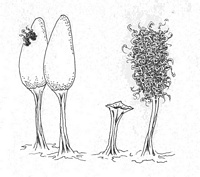|
 Arcyria cinerea Arcyria cinerea
SynonymsArcyria albida
Trichia cinerea
BiostatusPresent in region - Indigenous. Non endemic
Images (click to enlarge)
Caption: Three sporangia of Arcyria cinerea and a stalk from which the spores and capillitium have been lost. Each sporangium is about 3 mm tall.
Owner: S.L. Stephenson |
Article: Stephenson, S.L. (2003). Myxomycetes of New Zealand. Fungi of New Zealand. Ngā Harore o Aotearoa 3: xiv + 238 p. Hong Kong: Fungal Diversity Press.
Description: Fruiting body a stalked sporangium, scattered, gregarious or sometimes united by their fused stalks and occurring in digitate clusters of 2–20 or more sporangia, 0.3–4.0 mm tall. Sporotheca ovate to cylindrical, usually tapering toward the apex, pale grey to light brown, ochraceous or less commonly yellowish brown, 0.1–0.8 mm in diameter. Stalk slender, pallid to black, up to 2 mm in length. Hypothallus discoid or contiguous for a group of sporangia, transparent and often not evident. Peridium persisting in mature fruiting bodies only at the base of the sporotheca, where it forms a rather small, shallow calyculus with a smooth, delicately stippled, finely reticulate inner surface. Capillitium firmly attached to the calyculus, colourless or nearly so by transmitted light, consisting of a network of threads 2–6 µm in diameter and densely covered with small blunt spines (occasionally also with cogs, bands or reticulations). Spores pale grey or light yellow in mass, colourless by transmitted light, with a few scattered warts, 6–7 µm in diameter. Plasmodium white, less commonly grey or pale yellow.
Habitat: Decaying wood, bark, leaf litter, and dung.
Distribution: Cosmopolitan (Martin & Alexopoulos 1969). First reported from New Zealand by Lister & Lister (1905), based on a specimen collected in Taupo. Also known from Northland, Auckland, Coromandel, Buller, North Canterbury, South Canterbury, Dunedin, Southland, Stewart Island, and Campbell Island.
Notes: This very variable species is relatively common in the field and exceedingly so in moist chamber cultures, especially cultures prepared with samples of leaf litter from broadleaf trees.
|